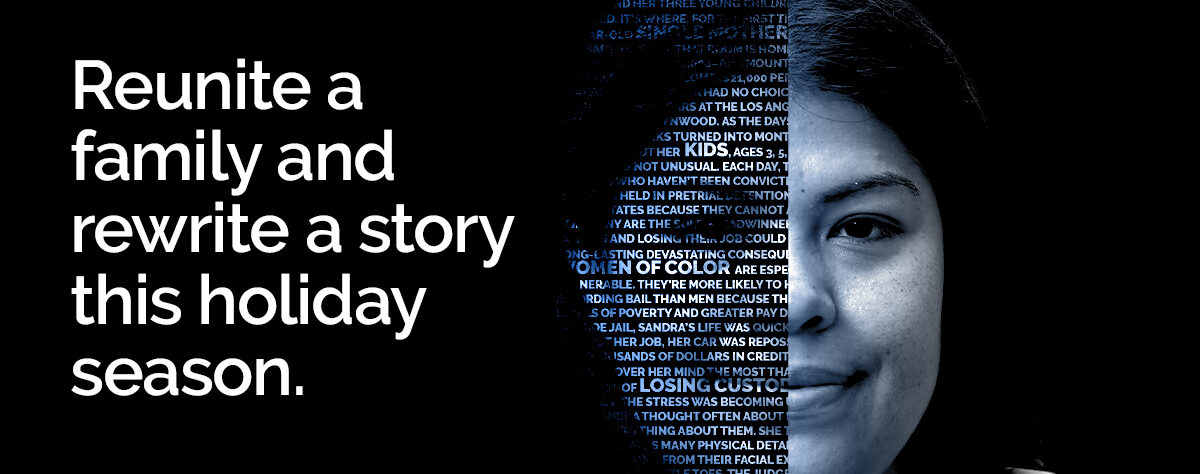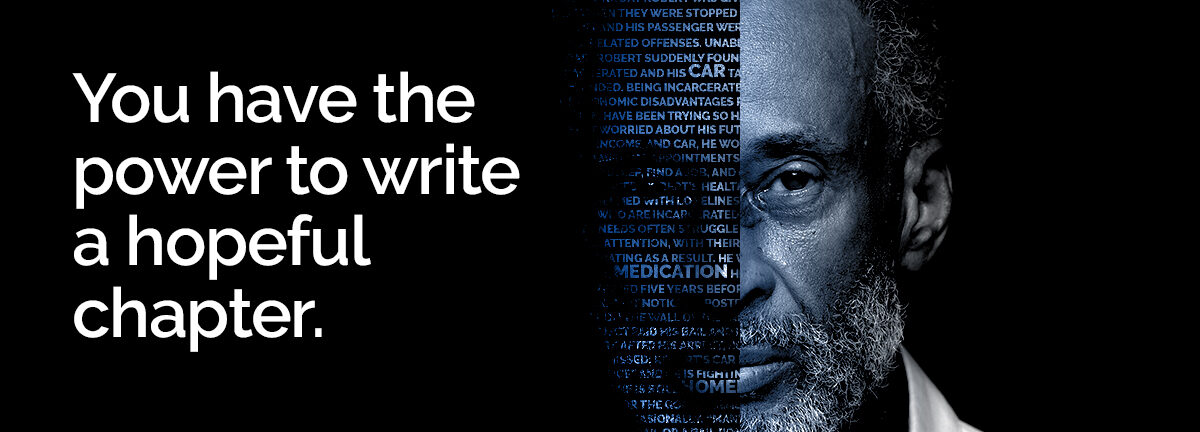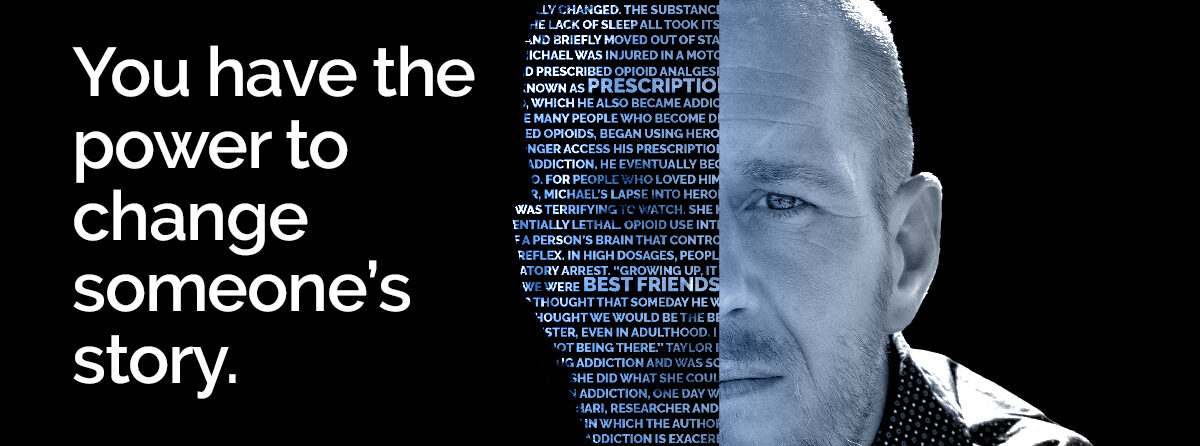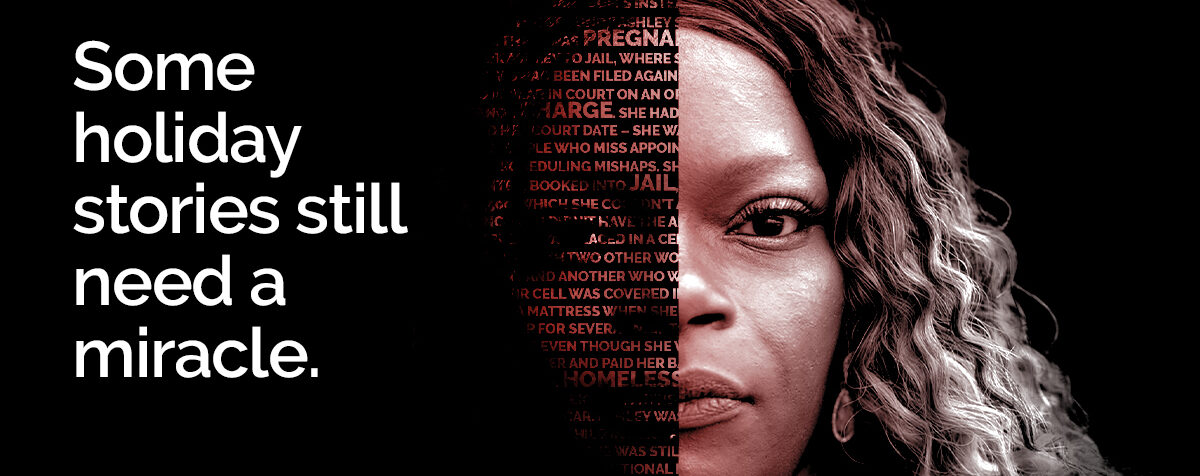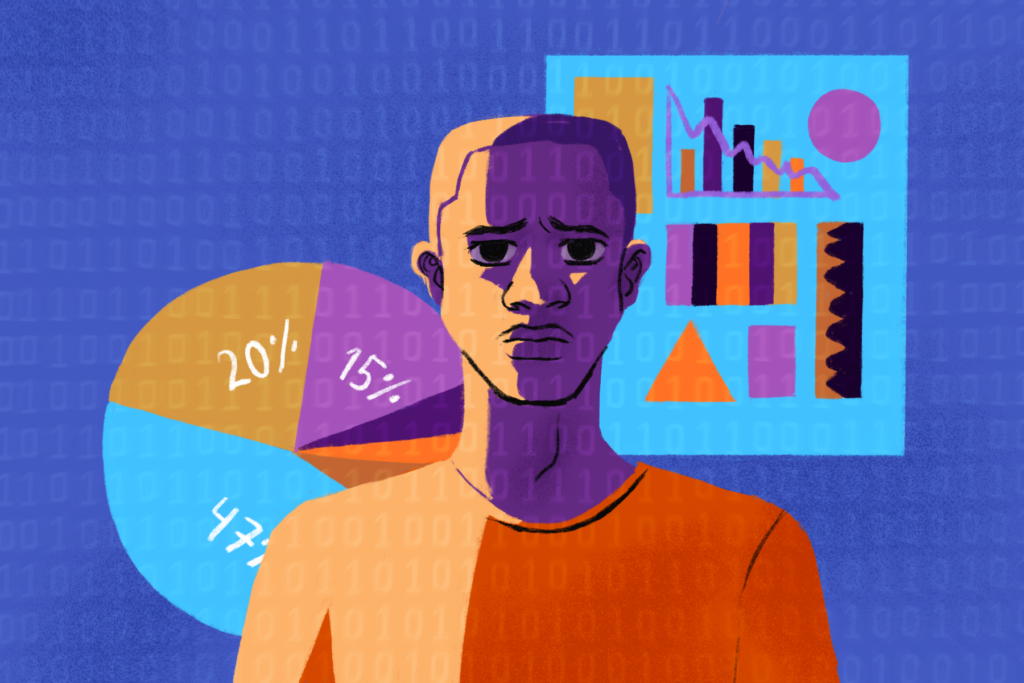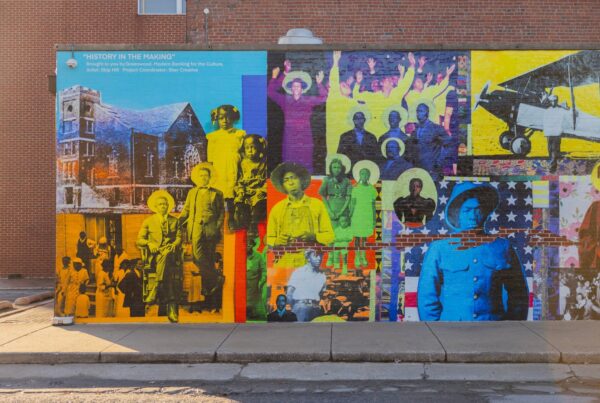
On any given day, nearly half a million people languish in jail cells across America, waiting for their criminal cases to move forward and severed from their lives and communities even though they have not been convicted of a crime.1Wendy Sawyer & Peter Wagner, “Mass Incarceration: The Whole Pie 2019,” Prison Policy Initiative, March 2019. It is no surprise that nearly one in two adults in the United States have had a loved one incarcerated. Brian Elderbroom, et al., “Every Second: The Impact of the Incarceration Crisis on America’s Families,” FWD.us, December 2018. People in pretrial detention now make up more than two-thirds of America’s jail population.2Wendy Sawyer, “How Race Impacts Who Is Detained Pretrial,” Prison Policy Initiative, October 2019. They are presumed innocent under the law, yet they will suffer the harms of incarceration unless they have enough money to pay bail and buy their freedom. This two-tier system criminalizes poverty and is a structural linchpin of mass incarceration3Pretrial detention is responsible for nearly all of the net jail growth in the last 20 years. Sawyer, supra n. 1. and racial inequality.4Black and brown people, for example, are at least 10 to 25% more likely than white people to be detained pretrial or to have to pay money bail. Sawyer, supra n. 2. It affects entire communities, devastates families for generations, and guts the presumption of innocence.
The human toll of this crisis is catastrophic, levied almost exclusively on the poor, and disproportionately on communities of color. People who are jailed pretrial often wait months, and sometimes years, for their cases to resolve. In the meantime, they can lose their jobs, homes, children, and critical community ties.5See Nick Pinto, “The Bail Trap,” New York Times Magazine, August 13, 2015. Inside jail, people risk sexual violence,6Over 23,000 people report being sexually assaulted in jail each year. Allen J. Beck, et al., “Sexual Victimization in Prison and Jails Reported by Inmates, 2011–12,” Dept, of Justice Programs, U.S. Dept. of Justice, May 2013, p. 6, (3.2% of people in jail reported experiencing incidents of sexual victimization in 2011–12); Lauren E. Glaze & Erinn J. Herberman, “Correctional Populations in the United States, 2012,” Dept. of Justice Programs, U.S. Dept. of Justice, December 2013, p. 4, (744,500 people in local jail in 2012). the deterioration of their mental and physical health,7See Steve Coll, “The Jail Health-Care Crisis,” The New Yorker, February 25, 2019. and the infliction of lasting trauma.8See Jennifer Gonnerman, “Kalief Browder, 1993–2015,” The New Yorker, June 7, 2015. They feel enormous pressure to accept an unjust or wrongful conviction just to go home.9Today in America, only 3% of federal cases and 6% of state cases go to trial. The rest are resolved by plea, whereby people are pressured to say they are guilty to avoid more serious charges and harsher sentences at trial. Erica Goode, “Stronger Hand for Judges in the ‘Bazaar’ of Plea Deals,” The New York Times, March 22, 2012. And, as with all other areas of the criminal legal system, people of color bear a far heavier burden due to an enduring legacy of racism and economic disenfranchisement.10Sawyer, supra n. 2.
Moreover, the financial costs that this system generates are staggering. American taxpayers pay $14 billion each year to incarcerate people pretrial.11Pretrial Justice Institute, “Pretrial Justice: How Much Does It Cost?” January 2017, p. 2. Meanwhile, the $2 billion bail industry, with its well-documented predatory and exploitative practices, extracts money from precisely those communities that have the fewest resources.12Gillian B. White, “Who Really Makes Money Off of Bail Bonds?” The Atlantic, May 12, 2017. A Million Dollar Hoods report revealed that between 2012 and 2016, accused people and their families in Los Angeles paid $193.8 million in nonrefundable fees to bail bond agents. Isaac Bryan, et al., “The Price for Freedom: Bail in the City of L.A.,” Million Dollar Hoods, December 2017, p. 1. Factoring in the impact of pretrial detention on families, communities, and social services, the true economic cost of this crisis has been estimated to approach $140 billion annually.13Pretrial Justice Institute, supra n. 11 at 2.
Most Americans recognize that our current pretrial system must change. But while there is growing consensus that we need reform, a shared vision for what this looks like is less clear. Without a focus on the larger systemic problems of which bail is a symptom—structural racism and mass incarceration—reform runs the risk of re-creating the harms and disparities of the current system even after ending cash bail.
To effect true change, two priorities must inform the transition to a fair justice system: first, eliminating pretrial detention except where absolutely necessary to prevent imminent violence or willful flight; and second, combatting the racial bias that pervades every corner of the American legal system and reinforces inequality. Overall success in this effort should be measured by the level of decarceration and reduction of disparities in how criminal justice is applied, not just the abolition of cash bail.
This document outlines a roadmap to a more just, equitable, and humane pretrial system.
It is grounded in our belief in the dignity of all people and the absolute need for oversight of and checks on the government’s power to take away a person’s liberty. It is informed by The Bail Project’s experience going into jails across the country and meeting thousands of people trapped by bail. By providing free bail assistance in over a dozen jurisdictions, and modeling, in real time, a community-based infrastructure for pretrial support, we have demonstrated our model’s efficacy in supporting high rates of return. Our clients’ stories shape this perspective, and many graciously shared their experience in the pages that follow.
If history has shown us anything it is that we cannot arrest and incarcerate our way out of systemic social problems. The Bail Project is committed to a future where no human being is ever forced to deteriorate in a jail cell, a future where a more sensible and equitable approach to social issues is possible. Pretrial reform is just one step in that direction; though it is an essential one, it must be accompanied by investments in alternatives to incarceration, community empowerment, police accountability, and new thinking on how we as a society respond to violence and other harm. The Bail Project offers the following framework as a starting point for grounding bail and pretrial reform in a broader vision of democracy, progress, and collective wellbeing.
1. End Cash Bail: Freedom Should Be Free
The cash bail system rests on the false assumption that people will not return to court unless they stand to lose money. In cities across America, clients of The Bail Project are demonstrating that this is not the case.
While the nonmonetary option of releasing people on a promise to return to court (“personal recognizance”) is already available to judges, many use it in only a fraction of cases. Barriers to wider use of this nonmonetary option include:
- The myth that people accused of crimes will not return to court unless they stand to lose their bail money;
- Racial bias in decisions about who is allowed to go free while their case is pending;
- Few incentives for judges to grant release on personal recognizance, relative to fears of public blame and media coverage if the person is released and rearrested;
- Limited legislation that sets rigorous procedural safeguards to protect against unwarranted pretrial detention; and
- Lack of public investment in services to support people in coming back to court as needed, while addressing root causes of criminal justice involvement.
Pretrial liberty should not be a question of money. The Bail Project’s work offers a blueprint for how jurisdictions can move away from cash bail, creating a more equitable process and ultimately eliminating the need for bail funds, including our own. Using a National Revolving Bail Fund, our community-based advocates, called Bail Disruptors, pay bail for thousands of people living in poverty every year and support them through the duration of their cases.14The Bail Project makes bail payments directly to the court, our services are free, and clients have no financial obligations to us. Because the principal stated purpose of cash bail is to ensure court appearance, Bail Disruptors ask our clients questions about obstacles to court return (e.g. transportation, unstable housing, health concerns) and design a support plan to help overcome these barriers through ongoing communication, effective court notifications, and voluntary referrals to social services and community-based programs.
This needs-focused approach removes the financial incentive of bail and creates the equivalent of releasing people on personal recognizance. We call this model Community Release with Support, and our experience and track record with thousands of bailouts show that it works. Despite not having any of their own money on the line, our clients consistently return for their court dates, laying waste to the myth that cash bail is effective or needed. At the vast majority of our sites, our clients appear for over 90% of their court dates.15Similar results are bearing out across the country. In 2018, the Philadelphia District Attorney announced his office would no longer request cash bail for numerous offenses. The number of people released without monetary conditions increased with no discernible change in failure to appear (or rearrest) rates. Aurelie Ouss & Megan Stevenson, “Evaluating the Impacts of Eliminating Prosecutorial Requests for Cash Bail,” George Mason Legal Studies Research Paper No. LS 19-08, February 25, 2019, p. 3, (“These results demonstrate that monetary bail can be replaced by release on recognizance for a sizeable number of defendants with no detectable impacts on nonappearance or pretrial crime.”). They show up because they’re provided with the supports they need, and because they want to resolve their cases. Occasional failures to appear are usually due to involuntary circumstances, such as housing instability, work schedule conflicts, and health or childcare crises. Cash bail does not make these kinds of obstacles go away; the financial burden of cash bail can, in fact, exacerbate them.
The Bail Project is modeling Community Release with Support across more than a dozen cities of varying demographics, geography, and political contexts, and can support uptake of this model to interested jurisdictions.
The sprawling geography of American cities, combined with a lack of public transit options, can make it difficult for some people to attend their court hearings. Add an unreliable system of court reminders and it can feel “like the system is made to fail you,” as our client Michael told us.16Names have been changed to protect the privacy of our clients.
” Right now, I use a lot of public transportation. I have to leave maybe two hours in advance (to get to court). If I have to be there at 8, I probably have to get up at like 4:30, catch a 6 o’clock bus and get to the transfer, and you don’t always have the time for any unexpected setbacks. So, I don’t really like to be at the last minute, that’s why I prepare at least two hours in advance when I ride the bus… If (The Bail Project) hadn’t called me up about this upcoming court date, I wouldn’t have known about it. If I wouldn’t have went, I would have had a bench warrant out, and I’m just starting a new job, and I’m not getting no correspondence (from the court)… it’s like the system is made to fail you.”
Legislation and court rules that have attempted to do so have proven unsuccessful and difficult to enforce. For example, in Cook County, Illinois, even when judges were required to set “affordable” bail amounts, they continued to set bail beyond what people could pay.17The Coalition to End Money Bond, “Monitoring Cook County’s Central Bond Court: A Community Courtwatching Initiative, August–October, 2017,” February 2018, pp. 24, 32–33. The reality is that for most American families, any amount of bail will be a financial hardship. Four out of ten Americans cannot cover a $400 unplanned expense.18Board of Governors of the Federal Reserve System, “Report on the Economic Well-Being of U.S. Households in 2017,” May 2018, p. 21. The Bail Project routinely assists people who are detained in jail on bails of this amount or less. There is no reason to continue to rely on cash bail when it is both financially oppressive and ineffective at actually returning people to court.
2. Pretrial Detention Must Be the Rare, Limited Exception
Americans are taught that the bedrock of the criminal legal system is that you are presumed innocent unless proven otherwise in a court of law. Pretrial detention upends this basic legal protection by turning the process into the punishment and then coercing people to forfeit their rights and plead guilty. It is also counter-productive: jails don’t heal, they harm; and often they exacerbate the circumstances driving a person into contact with law enforcement in the first place. When you consider the destabilizing and traumatic impact that incarceration can have on a person and their family, it is no surprise that, as research shows, the longer someone is held in pretrial detention, the more likely they are to be rearrested later.19Compared to someone held for one day or less, people held in pretrial detention for 8–14 days are 56% more likely to be rearrested before trial and 51% more likely to be recidivate after sentence completion. Ram Subramanian, et al., “Incarceration’s Front Door: Misuse of Jails in America,” Vera Institute of Justice, February 2015, p. 14. To the extent that some form of pretrial detention will be needed in exceptional circumstances, we must begin by greatly narrowing its current scope, through decreasing the number of people subject to the process and through rigorous procedural safeguards for those that are. At the same time, we must advance new approaches that can actually address the roots of violent behavior. There is no question that any form of preventive detention must be radically safer, more humane, and more conducive to rehabilitation than today’s jails. And it is equally essential that we continue to challenge ourselves to move past the paradigm of incarceration in search of real solutions to violence.
Decriminalize. Transformative pretrial change should begin by ensuring that arrest and incarceration are not the default responses to issues of poverty and public health in the first instance. Congress and state legislatures have greatly expanded statutory criminal codes through counterproductive and discriminatory policies like the “war on drugs” and the explosion of so-called “quality of life” offenses, which are typically associated with poverty. Jurisdictions should begin by narrowing their criminal statutes and decriminalizing behaviors that are better addressed through a public-health and community-investment approach, outside the criminal legal system.20Over 4.9 million people are arrested and booked into jail each year. That’s higher than the population of 24 states in the U.S. One in four of those people are booked in jail more than once during the same year. Alexi Jones & Wendy Sawyer, “Arrest, Release, Repeat: How Police and Jails Are Misused to Respond to Social Problems,” Prison Policy Initiative, August 2019. Decriminalization makes communities stronger and safer by allowing people to remain in their communities, to work, to attend school, and to care for their families, rather than destabilizing them.
Inadequate medical care in local jails, a majority of which outsource healthcare services to private companies, is a widespread hazard facing people locked up because they cannot afford to post bail. Our client Paloma, who was unable to access vital medication while incarcerated pretrial, describes her experience in pretrial detention:
In there, I wasn’t getting taken care of well. I wasn’t getting the proper stuff that I need. I’m a diabetic, they wasn’t giving me the right medication that I needed to keep my sugar low as far as where it needed to be level… Being inside of there, there’s no care in the world…
Our client Mary shared a similar account:
When I pushed the button and told them that I thought I was having (a miscarriage), they brought me a trash bag and pads, and told me to fill it up (with blood) every hour and let them know. It was mind blowing, extremely inhumane.
Mandate the use of noncustodial citations in lieu of arrest.21We use the term “citation” to refer to a noncustodial notice to appear in which officers provide someone with a notice and summons to appear in court (a “citation”) without placing the person in custody. It is imperative that the elimination of custodial processing and arrest not eliminate or diminish legal protections, such as the right to counsel, that are triggered by a criminal prosecution. For those offenses that remain classified as criminal, statutes should require police to issue a noncustodial citation in place of arrests for the broadest amount of people possible. Noncustodial citations eliminate the degrading and often painful process of being handcuffed and arrested. They also reduce harms such as separating parents from children, lost work, and missed school and medical appointments. In addition, mandatory citation policies offer cost savings for jurisdictions in officer time and detention costs.22Rachel A. Harmon, “Why Arrest?” Michigan Law Review 115:307 (2016), pp. 310–20, (estimating that arrests cost state and local governments $1.8 billion each year in officer time alone). Citations should not impose conditions of release beyond a promise to appear in court, and forms should be clear and easy to follow. In 2016, New York City redesigned its summons form to make the most relevant information stand out, making it easier for people to respond appropriately. The new forms reduced failures to appear by 13% and prevented roughly 17,000 arrest warrants per year.23Brice Cooke, et al., “Using Behavioral Science to Improve Criminal Justice Outcomes: Preventing Failures to Appear in Court,” ideas42 & University of Chicago Crime Lab, January 2018, p. 4. Jurisdictions mandating an increased use of citations should also implement safeguards to ensure that this change does not feed an increase of criminal cases.24Editorial Board, “New York’s Unfair Summons System,” The New York Times, April 28, 2015.
Incarceration is a dehumanizing and often dangerous experience. At the jail where our client Michael was incarcerated pretrial, 25 people died between 2012 and 2016.25Teresa Mathew, “Most Recent Deaths at East Baton Rouge Jail Could Have Been Avoided,” The Appeal, August 15, 2018.
When you’re in jail, you’re just, I mean, you’re just their property. It felt like we were commodities. Property… I don’t think it’s fair. It’s no respect. It’s suicide in there. I mean, you know, you see all kinds of stuff.
Charge-based distinctions could be employed to limit eligibility nets. For example, New York’s recent pretrial reform legislation fully removes the option of pretrial detention for most misdemeanors as well as for many felonies. Those offenses comprise 90% of all arrests across New York, and the new law requires people charged with those offenses to be released without bail.26Insha Rahman, “New York, New York: Highlights of the 2019 Bail Reform Law,” Vera Institute of Justice, July 2019, p. 8.
Charge-based approaches, however, reinforce the general, mistaken perception that charges are more akin to convictions than they are to mere accusations, and this misperception can lead to misuse as proxy for the two risks relevant to the pretrial context: imminent violence or willful flight. It is worth noting that studies consistently show that people charged and convicted of the most serious offenses are among the least likely to be rearrested after release.27Sawyer, supra n. 1 (“The data supports changing our responses to some of the crimes that scare people most: people convicted of sexual assault and homicide are actually among the least likely to reoffend after release. People convicted of homicide are the least likely to be rearrested, and those convicted of rape or sexual assault have rearrest rates roughly 30 to 50% lower than people convicted of larceny or motor vehicle theft. More broadly, people convicted of any violent offense are less likely to be rearrested in the years after release than those convicted of property, drug, or public order offenses.”). Worse, charge-based distinctions may incentivize prosecutors and police to “overcharge,” or charge a single offense at a higher level than the circumstances reasonably warrant.28Andrew Manuel Crespo, “The Hidden Law of Plea Bargaining,” Columbia Law Review 118:5, pp. 1310–1314, (listing the different ways prosecutors attempt to control case outcomes “by manipulating the charges”). We also know that charging decisions are riddled with racial biases.29Sonja B. Starr & M. Marit Rehavi, “Racial Disparity in Federal Criminal Charging and Its Sentencing Consequences,” University of Michigan Law and Economics Working Paper Series, Working Paper No. 12-002 (May 2012).
Ultimately, no studies have analyzed the equity impact of policy changes that rely on charge-based distinctions in the pretrial context. Until further empirical research is conducted, advocates working to bring this vision statement to life in their own communities should carefully consider the ways charge-based distinctions could both help and hurt accused people, along with the unique circumstances of their own pretrial justice systems, before charting a path forward.
Require the presumption of unconditional release. Everyone has a fundamental right to pretrial liberty and is presumed innocent under the law.30United States v. Salerno, 481 U.S. 739, 755 (1987) (“In our society, liberty is the norm, and detention prior to trial or without trial is the carefully limited exception.”). Consistent with these basic principles, a strong presumption of release without conditions must be enshrined by statute—unless the prosecutor can meet the high standard described below, any person who is arrested and booked into jail must be released within 24 hours of arrest, without any conditions other than an order to appear in court.
The only government interests compelling enough to justify departing from this rule and restricting someone’s pretrial liberty, including through the imposition of pretrial release conditions, is to protect against an imminent risk of violence or willful flight. By this, we mean a substantial and imminent risk that the person will inflict serious bodily harm to a reasonably identifiable person or a substantial and imminent risk that the person will intentionally flee the jurisdiction. These are the only two circumstances in which a person may be incarcerated pending trial.
If the prosecution has sufficient evidence that one of these risks are present, it may file a motion within 24 hours of arrest establishing the existence of the risk by clear and convincing evidence. The clear and convincing evidence standard is a high threshold; it means that the prosecution must submit actual evidence proving that the alleged risk is substantially more likely than not to exist. It also means that the risk cannot be assumed based solely on the underlying charge. For example, the prosecution could not meet this standard by arguing that someone is likely to flee merely because that person is facing a long prison sentence or because the person has family that lives outside of the jurisdiction.
Require substantive hearings with robust due process protections. If the prosecution files a timely motion seeking pretrial release conditions or pretrial detention, the court must hold a substantive, individualized hearing that includes the following due process protections:
- An adversarial, in-person hearing in a public courtroom;31Courts are increasingly holding hearings remotely by video from inside jail. This further dehumanizes the person behind the screen and has a significant negative impact on case outcomes, perhaps since judges might feel more free to treat someone harshly when they do not face them in person. Bryce Covert, “Video Hearings: The Choice Between Efficiency and Rights,” The Appeal, June 5, 2019, (citing study demonstrating that bail amounts increased 51% when in-person hearings were eliminated).
- Representation of the accused person by competent counsel, with counsel appointed for people who cannot afford to pay on their own;
- The right of the accused person to testify, present evidence, and cross-examine witnesses;
- The submission of non-hearsay evidence adduced pursuant to the rules of evidence;
- The right of the accused person to review the prosecution’s evidence before the hearing;
- The prosecution’s burden to establish the existence of the risk by clear and convincing evidence;
- If the Court denies unconditional release, findings set forth in an appealable order specifically documenting the risks, need for the detention, and supporting evidence.
The Court should hold this hearing and make the determination described above within 24 hours of any motion being filed. Accused people should be afforded the right to adjourn the hearing for 48 hours in order to gather and present evidence undermining or refuting the prosecution’s position on release conditions or pretrial detention. Additionally, accused people should be guaranteed the right to appeal any order imposing pretrial detention or any condition of pretrial release. They should also be given the right to move to reconsider such an order periodically or when new information becomes available.
Will these due process requirements overwhelm courts?
No. Under this framework, there will be fewer cases and fewer hearings. The vast majority of people will be released at arrest through noncustodial citations or automatically within 24 hours of booking. Moreover, courts will only need to hold hearings if the prosecution has sufficient evidence to file a motion alleging that an accused person poses an imminent risk of violence or willful flight. Because both of these risks are exceedingly rare—and because courts will no longer be conducting routine bail determinations for nonessential cases—courts’ limited resources can be focused on making meaningful, individualized determinations when it matters the most.
Require that any conditions are the least restrictive necessary. As we scale our program of free bail assistance across the country, we increasingly see jurisdictions seeking to replace cash bail with onerous pretrial release conditions such as curfews, mandatory alcohol/drug testing, home incarceration, and electronic monitoring.32The number of people monitored with electronic tracking devices, for example, increased 140% between 2005 and 2015, from approximately 53,000 people to more than 125,000. The Pew Charitable Trusts, “Use of Electronic Offender-Tracking Devices Expands Sharply,” September 2016, p. 1. These conditions can re-create the harms of cash bail, leading to the loss of employment, childcare issues, and obstacles seeking medical treatment. Onerous release conditions also expose people to involuntary technical violations that trigger rearrest, again re-creating the harms of cash bail.33See Cecelia Klingele, “Rethinking the Use of Community Supervision,” Journal of Criminal Law and Criminology 103:4 (2013); Eli Hager, “At Least 61,000 Nationwide Are in Prison for Minor Parole Violations,” The Marshall Project, April 2017. In the parole context, numerous studies have shown that jurisdictions can maintain public safety and possibly even improve it with less supervision. See Jennifer L. Doleac, “Study After Study Shows Ex-Prisoners Would Be Better Off Without Intense Supervision,” Brookings, July 2, 2018.
No condition of pretrial release should be available unless a judge can find by clear and convincing evidence that a person poses either a substantial and imminent risk of serious bodily harm to a reasonably identifiable person or a substantial and imminent risk of willful flight and that no less restrictive condition or combination of conditions could reasonably mitigate the identified risk, and any condition that is imposed must be the least restrictive necessary. In addition, no accused person should be charged fees or assessed costs for any release conditions or pretrial detention imposed by a court, as this would again replicate the economic inequity of cash bail.
Invest in restorative justice and non-carceral responses to harm. Mass incarceration not only perpetuates racial and economic inequality–it also fails to reduce crime and prevent violence.34Don Stemen, “The Prison Paradox: More Incarceration Will Not Make Us Safer,” Vera Institute of Justice, July 2017. The above recommendations can help ensure that pretrial detention is the rare exception of last resort, but enduring change in how we practice justice will also require a proactive strategy to address the root causes of violent behavior and create spaces for accountability that are responsive to the unique and complex needs of survivors, rather than an impulse for retribution. A non-carceral response to violence must be our ultimate goal in order to truly transform the conditions that lead to it and free future generations from our reliance on jails and prisons. Restorative justice models are growing throughout the United States and across the world, along with evidence of their success and potential.35Organizations like Common Justice, for example, have developed successful strategies to break cycles of violence and secure safety, healing, and justice for survivors and their communities. See Common Justice, Our Work. These initiatives must be an area of focus and investment as states look to reform their pretrial systems.

What about electronic monitors?
Electronic monitoring (EM) does not fully curtail someone’s ability to move through society freely in the same way that jail does, but it often has the same incapacitating and dehumanizing effect. The rules for wearing a monitor are extremely restrictive and limit people’s freedom in ways that make it challenging, and often impossible, to hold jobs, seek medical treatment, or reintegrate into their families and communities.36See, e.g., Jack Karsten & Darrell M. West, “Decades Later, Electronic Monitoring of Offenders Is Still Prone to Failure,” Brookings, September 21, 2017; Olivia Thompson, “Shackled: The Realities of Home Imprisonment,” Equal Justice Under Law, June 14, 2018; Paige St. John, “Parolee GPS Ankle Monitors: Major Flaws Found in Vendor’s System,” Los Angeles Times, March 31, 2013. Costly daily user fees drive people in debt,37Our St. Louis site saw a large increase in EM requirements after a federal judge ruled the city’s bail setting practices unconstitutional. There, monitoring devices cost $300 a month, and those who miss a payment risk being sent back to jail. Carolina Hidalgo, “As St. Louis Tries to Reform Bail System, Advocates Warn about Increase in Ankle Monitoring,” St. Louis Public Radio, June 27, 2019. while charging requirements, frequent beeping, and device malfunctions keep them one step away from being jailed for technical violations.38See supra n. 34. On the flip side, law enforcement officers can be inundated with thousands of daily alerts, errors, and false positives. Those who have studied the devices for years have found no evidence showing that they make communities safer or improve appearance rates.39James Kilgore, “Electronic Monitoring: A Survey of the Research for Decarceration Activists,” Challenging E-Carceration, July 2018, p. 1, (“[T]here is no serious, rigorously executed research providing significant evidence that electronic monitoring has a positive impact on the person being monitored.”); J. Robert Lilly & Mike Nellis, “The Limits of Techno-Utopianism: Electronic Monitoring in the United States of America,” in Mike Nellis et al. (eds.), Electronically Monitored Punishment (Routledge, 2013), p. 21 (observing that despite extensive literature on electronic monitoring in the U.S., there “leaves a lot to be desired, methodologically and substantively . . . and few academic commentators believe that [electronic monitoring’s] growth has been informed by significant evidence of its effectiveness”).
No one should ever have to make the choice between physical incarceration and its virtual counterpart. An important first step in reducing the harms of EM in the immediate future is to ensure that jurisdictions recognize it as what it is: a new form of pretrial detention.40Even though the imposition of EM poses a significant threat to liberty, courts often impose it as a condition of pretrial release with relative ease, and without necessary procedural safeguards. “[V]irtually no legal constraints circumscribe the use of [incarceration’s] technological counterpart.” Erin Murphy, “Paradigms of Restraint,” Duke Law Journal 57:5 (2008), pp. 1321–1411, see especially pp. 1345–46. The lack of procedural and other protections exposes jurisdictions to constitutional and other legal challenges and should be deeply troubling to lawmakers. In this actual context, EM’s use should be subject to the very same due process requirements outlined above—it may be ordered only if a court finds that someone poses a substantial and imminent risk of serious bodily harm to a reasonably identifiable person or a substantial and imminent risk of willful flight, and that no less restrictive condition, or combination of conditions, could reasonably mitigate the identified risk.
Electronic monitoring is dehumanizing.
My ankle is very small and they put it on as tight as they could,” said our client Karina. ” I’m a nurse’s assistant at a hospital, so for me, I’m walking around all the time and I can’t sit down, the bracelet is jumping up and down on my ankle… It’s been several times I’ve had to leave work (to charge it). Several times I’ve gone to McDonald’s or Arby’s because if it dies, I go back to jail. Almost like it’s set up to get you in trouble.
Electronic monitoring is a form of incarceration, not an alternative to it.
You’re supposed to be innocent until proven guilty,” said our client, 17-year-old Josh. ” Well, you know, put someone on (electronic monitoring) is like saying well, you’re automatically guilty… just wait until you go to court, that’ll be the final thing, but you’re already guilty, they’re looking at you as if you did this. This right now is time served.
Electronic monitoring can recreate the economic injustice of cash bail.
I definitely don’t have six, seven, or even 300 dollars to take out of my pocket and give to them (for my ankle monitor),” said our client Malea. “There’s no way, it’s unrealistic… That’s part of life, you have to pay bills to live, you know what I mean… And I only get paid $3 an hour.
3. Return People to Their Communities and Provide Support
The Bail Project’s framework enshrines a presumption of release as the default. In this section, we outline our model of Community Release with Support, which begins by assessing a person’s basic needs. “Pretrial services” are too often synonymous with onerous forms of supervision that see individuals through a lens of risk rather than need. However, our experience providing free bail assistance and support to thousands of people across the United States demonstrates that, where additional support is needed, addressing people’s needs is not only the most humane way to run a pretrial system: it’s also effective at ensuring high rates of court appearance and creating opportunities for meaningful interventions that can prevent further criminal justice involvement. This also means making the court system less challenging to navigate by reducing the burdens people face when appearing for their court dates. In short: we must ensure that the process is not the punishment.
Focus on solving common obstacles to court return rather than the minimal risk of flight. There is a common misconception that court nonappearance is at crisis proportions and that people who miss court do so deliberately. Data and our experiences tell a very different story. In reality, most instances of nonappearance result from common obstacles that include work schedules, childcare responsibilities, lack of access to adequate transportation, and difficulty navigating confusing court systems.41See Lauryn P. Gouldin, “Defining Flight Risk,” University of Chicago Law Review, 85:677 (2018), pp. 729–35; Daniel Bernal, “Note, Taking the Court to the People: Real-World Solutions for Nonappearance,” Arizona Law Review 59:547 (2017), 547–71. As a result, pretrial support should focus on addressing these obstacles and making it easier for people to return to court.42It is also important to note that many of these aforementioned obstacles to court appearance are, in and of themselves, highly racialized. Communities most at risk of being overpoliced and disproportionately funneled into the criminal legal system—namely, communities of color—are often also those most likely to face a lack of investment in public transport and inflexible work schedules. Willful flight from a jurisdiction is a very rare cause of nonappearance and the system should not be designed around that scenario.43See Gouldin, supra n. 41, pp. 689, 725–28; Bernal, supra n. 41, pp. 556–57; New York City Criminal Justice Agency, “Annual Report 2016,” (2018), p. 36, (93% of people released pretrial in New York City in 2016 appeared in court voluntarily within 30 days of their scheduled court dates).
Invest in court reminders, free or subsidized transportation to court, and childcare assistance. Our experience demonstrates that simple measures such as text and phone call reminders about court dates,44In one study, implementing text message reminders reduced nonappearance rates by 26%. Cooke, supra n. 23 at 15–16. transportation assistance to and from court, and problem-solving around childcare, substantially improve appearance rates. At our Indianapolis site, for example, 70% of clients tell us they need transportation support and 75% have children or are pregnant at the time of their arrest. Sometimes all that is needed is a conversation to talk through plans to get to court. As noted above, at the vast majority of our sites, our clients appear for over 90% of their court dates after receiving these voluntary, supportive interventions.
Develop effective systems of voluntary referrals to social services and community-based organizations. Arrests throw lives into turmoil and most often impact people whose circumstances are already precarious. Some people’s needs may go beyond court reminders. For example, at our site in Spokane, 86% of our clients report a history of drug addiction, 76% say they are unemployed, and 44% say they are homeless or have unstable housing. The pretrial system can either be a profound disruption or a positive intervention point for connecting people with supportive services such as housing assistance, job training, and substance abuse treatment.45We do not advocate that the pretrial system be the first intervention point for connecting people with community-based supportive services. Ideally, these needs would be identified and met long before someone comes into contact with police or courts, lessening the need for punitive state intervention and criminalization in the first place. The institutional design of how supportive services are identified and coordinated can help prevent community release from drifting toward coercive practices that expand the power and reach of the carceral system. While there is no one correct way to structure the delivery of supportive services, there are a few important guideposts.
First, funding independent organizations that provide these services is a necessary component of transforming pretrial justice. Existing community-based organizations, networks, and nonprofits should be given the greatest role possible, with the goal of empowering communities. In addition, referrals to these services should be offered rather than required and must be independent from people’s criminal cases. Mandating participation and court oversight of compliance can expose people to rearrest and incarceration for seeking help. This is particularly counterproductive in situations of drug addiction. Participation and compliance should not impact a person’s criminal case negatively.
Second, if jurisdictions opt to have government agencies coordinate supportive services, they should not house services within probation departments or other law-enforcement agencies. The sole functions of pretrial services should be to facilitate return to court and respond to the underlying needs that an accused person may have. People are far less likely to have honest conversations about issues in their lives such as drug addiction, mental health, and anger management if these conversations are with someone they associate with law enforcement. In addition, pretrial services personnel serve people who are presumed innocent, many of whom will never be convicted. It is unrealistic to expect law enforcement agencies, who are used to working within the legal parameters applicable to people convicted of crimes, to respect the expanded rights of legally innocent people. Similarly, for-profit businesses should play no role in the provision of pretrial services, as this creates perverse monetary incentives that inevitably lead to abuse.
Even after The Bail Project connected our client Rudy to local organizations that provide transitional housing and substance abuse treatment, he still said what mattered most was “knowing that I had people who cared.” He told our Bail Disruptor who bailed him out,
I was lost, I had nowhere to go, I had nobody to turn to. I don’t know. It’s just, I had nothing. I had nothing. But you, you encouraged me. You talked to me. You inspired me. You lifted me up without a doubt. You really showed you cared. That’s something that . . . something I hadn’t had in a long time, somebody who actually cared. And that was, that made me feel good.
Make nonessential court hearings optional. From arraignment to verdict, a typical criminal case often has far too many court dates, some for procedural matters handled entirely by lawyers, such as serving motions and settling discovery disputes. For each of these court dates, a person must make arrangements to come to court, including finding childcare and transportation, and will often miss an entire day of work or school for a five-minute court hearing concerning the scheduling of an adjournment and procedural matters. Just as in civil courts, criminal courts should require a person to appear only for significant substantive proceedings and allow their counsel to represent their interests during all other court dates.
Improve court scheduling and rescheduling practices. Judges should schedule required court dates for specific time windows, so that people do not need to appear in court in the early morning for proceedings that might not begin until the late afternoon, or vice versa. This can minimize the amount of disruption in a person’s employment and other responsibilities, and reduce failure to appear for involuntary reasons. For example, court dockets could be scheduled in two-hour intervals or in morning and afternoon shifts. Courts should also implement uniform rescheduling policies that allow people to reschedule a certain number of court dates per case without the court’s permission, in case last-minute obstacles, such as a medical or childcare emergency, arise. Courts should maintain hotlines or websites that allow for ease of rescheduling.
Institute grace periods for nonappearance. Warrant grace periods grant accused people a certain amount of time to appear in court after a missed court date before a judge may issue a bench warrant.46Multiple jurisdictions at the epicenter of pretrial reform are experimenting with warrant grace periods, including New York, which included warrant grace periods in its recent and historic pretrial reform legislation, and Harris County, Texas, which included warrant grace periods and an Open Hours Court in its agreement to settle a longstanding constitutional challenge to its bail system. Grace periods for nonappearance save officer time and decrease costs for jurisdictions by avoiding unnecessary arrests and periods of incarceration. After the requisite time period, the court may issue a bench warrant if the court has made reasonable, documented efforts to notify the person and facilitate appearance. There are a number of ways to facilitate warrant grace periods. For example, courts may create an Open Hours Court where anyone who has missed a court appearance can appear and reschedule within a certain amount of time without fear of returning to jail.
4. Treat People as People, Not Statistical Risks
As counties begin moving away from cash bail, systems that rely on big data pretrial algorithms—or, as they’re commonly known, “risk assessment instruments”—are rapidly becoming the go-to replacements. By defining people as “risks” based on past data from the criminal legal system, pretrial algorithms reinforce racial disparities while doubling down on a logic of criminalization and dehumanization. These tools are fundamentally at odds with basic principles of the American legal system, including the principle that each person be judged as an individual. Risk assessment instruments must be rejected wholesale in favor of substantive hearings with rigorous evaluations of evidence, procedural protections, and high standards of proof.
How pretrial algorithms work. By crunching large volumes of criminal history data, pretrial algorithms produce predictions about a person’s future behavior based on patterns of how other people with purportedly similar data points behaved in the past. Algorithms draw on discrete data points about a person, like prior convictions, length of current employment, and even zip code. Many tools communicate this information to judges with simplistic labels such as “low,” “moderate,” and “high” risk; these labels obscure the deep uncertainty of the underlying predictions. These tools can be and often are used to produce false characterizations of people involved in the criminal legal system: the scoring of any risk assessment system can be adjusted to fit more or fewer people into certain risk categories, thus allowing the system to be manipulated to increase or lower the number of people detained pretrial.
Being incarcerated for months felt “like the world’s crashing down on you,” said our client Bineh.
You don’t see the brighter picture because you’re not in a brighter surrounding. You don’t have anything positive to look forward to when you’re in jail.
Pretrial algorithms perpetuate racial and economic inequality. Because pretrial algorithms rely on data and standardized processes, proponents offer them as a solution to judicial bias. But there are two key problems. First, algorithms are only as good as their data. Like all equations, if you give them faulty inputs, they will return faulty answers. Here, the data used to build pretrial risk assessments are inherently flawed and racially biased. From police deployment, to arrests, to charging decisions, to convictions and sentences, every aspect of the American criminal legal system is riddled with racial and economic disparities. By using tainted data to guide predictive pretrial release decisions, pretrial algorithms project these inequities into the future under a veneer of objectivity and science. “Given the nature of prediction, a racially unequal past will necessarily produce racially unequal outputs.”47Sandra G. Mayson, “Bias In, Bias Out,” The Yale Law Journal 128:2218 (2019), pp. 2218–2300, see especially p. 2224. In at least two states where pretrial algorithms are currently in place, racial disparities in pretrial detention have not decreased. In New Jersey, cash bail has been abolished for certain alleged crimes in favor of a system that relies in part on pretrial algorithms to forecast risk of flight and danger. However “the racial and ethnic makeup within New Jersey’s jail population has remained largely the same.” Glenn A. Grant, “2018 Report to the Governor and the Legislature,” New Jersey Judiciary, April 2019, p. 27. Similarly, in Kentucky, where pretrial algorithms have been used for decades, “racial disparities remain[ed] constant,” and jail growth is on the rise. Megan Stevenson, “Assessing Risk Assessment in Action,” Minnesota Law Review 103:303 (2018), pp. 303–84, see especially p. 309. In 2018, more than 100 civil rights organizations and community groups published a shared statement of concerns about the biases inherent in these instruments.48Statement, “The Use of Pretrial ‘Risk Assessment’ Instruments: A Shared Statement of Civil Rights Concerns,” July 2018. The following year, 27 experts in the fields of statistics, machine learning, artificial intelligence, and law, from MIT, Harvard, Princeton, New York University, and other leading academic institutions, released a statement condemning the data used to build these tools as fundamentally flawed and concluding that there are “no technical fixes.”49Statement, “Technical Flaws of Pretrial Risk Assessments Raise Grave Concerns,” July 2019.
The second problem is that biased judges can easily use the tools in biased ways. After all, risk assessment tools do not make definitive decisions about pretrial release. They merely aid and inform judges, who act as the final arbiters. In a recent Harvard experiment, participant interactions with risk assessment tools introduced new forms of bias into decision-making: when evaluating Black accused people, participants were 25.9% more strongly influenced to increase their risk prediction at the suggestion of the risk assessment and were 36.4% more likely to deviate from the risk assessment toward higher levels of risk.50Ben Green & Yiling Chen, “Disparate Interactions: An Algorithm-in-the-Loop Analysis of Fairness in Risk Assessments,” in FAT* ’19: Conference on Fairness, Accountability, and Transparency (FAT* ’19), January 29–31, 2019, Atlanta, GA, p. 2. Similarly, a recent study of the use of risk assessment tools in Kentucky showed judges were more likely to overrule the default recommendation to waive a financial bond for moderate-risk accused people if the accused person was Black.51Tim Simonite, “Algorithms Should’ve Made Courts More Fair. What Went Wrong?” Wired, September 5, 2019.
Pretrial algorithms cannot accurately predict the relevant risks. Our model recognizes that there may be certain limited circumstances where it may be appropriate to temporarily detain or impose pretrial conditions (i.e., if someone poses a substantial and imminent risk of inflicting serious bodily harm to a reasonably identifiable person or a substantial and imminent risk of willfully fleeing the jurisdiction). But, as some researchers have pointed out, “risk assessments are virtually useless for identifying who will commit violence if released pretrial.”52Chelsea Barabas, et al., “The Problems with Risk Assessment Tools,” The New York Times, July 17, 2019; Statement, supra n. 49. Because pretrial violence is so rare, “it is virtually impossible for any statistical model to identify people who are more likely than not to commit a violent crime.”53Id. Further, no tool used today even purports to isolate and predict risk of willful flight. Instead, current tools treat all nonappearances equally.54Gouldin, supra n. 41 at 684. Put differently, pretrial algorithms purport to predict risks that aren’t even relevant to pretrial release decision-making.
Pretrial algorithms ignore people’s individuality and the promise of positive change. Pretrial algorithms violate the fundamental principle that the legal system’s treatment of people should be based on a person’s actions and choices, not the choices of others in the demographic that they happen to be in. Pretrial algorithms also ignore the possibility that people’s life circumstances can change for the better. They fail to recognize what our clients have proven thousands of times—that “it is possible to change the odds” through supportive services that address people’s needs.55Mayson, supra n. 47 at 2287. Pretrial algorithms tell courts nothing, for example, about the likelihood that a person who receives a ride to court or housing assistance will appear in court. It is for precisely this reason that pretrial algorithms are incompatible with a pretrial system that responds to people’s needs with support instead of punishment.
Our client Bineh lives in a jurisdiction where pretrial algorithms are already in use. She said it felt “hurtful” to be reduced to a risk score.
There were so many feelings you have running in your mind at that moment because you’re like, out of all of this time that I haven’t been in trouble or even had a police call, now this is what you’re basing my case off, a number? People don’t know you, they think they know you because of one piece of paper and one data thing, and you can’t tell someone’s whole life story through a number or through an allegation.
5. Ensure that Progress Outlasts Us
History shows how easily oppressive systems can adapt to reforms and find new ways to harm and exploit. Policy reforms alone cannot break that cycle. In order to ensure decarceration is lasting and continues to drive progress, we need to invest in diverting resources away from policing and incarceration, increase transparency to monitor success, and—perhaps most importantly—enable communities to direct reform. We cannot truly reimagine pretrial justice without investing more deeply in our communities. We best ensure public safety when our children can get a good public education, when our families have access to safe, affordable housing, when all community members have access to mental health services and addiction treatment, and when we respond to violence in ways that restore and heal.
Invest in social services and resources. Transformative pretrial change will inevitably require up-front investment. However, jurisdictions can expect to see cost savings over time, as the size of the pretrial detention population decreases and jails close. All cost savings attributable to pretrial change should be reinvested into the community, shifting resources away from incarceration and toward long-term investments that actually make communities safer and help people thrive, such as education, health care, and employment services. Investments in organizations focused on reducing violence and building stronger communities lead to better safety than policing and punishment.56Patrick Sharkey, et al., “Community and the Crime Decline: The Causal Effect of Local Nonprofits on Violent Crime,” American Sociological Review 82:6 (2017).
This time has taught me that everything can be taken from you in a heartbeat, whether my family, the child, loved ones, possessions, anything. And it’s just made me think I want to cherish every single day, I want to make the best of every single day that I can.
Let communities decide what they need. Investment decisions should be determined by the community, though processes to identify the root causes of harm and fund community-led work that helps address those issues outside the paradigm of policing and imprisonment. Jurisdictions should explore and expand models that enable community members to identify their community’s most pressing needs and guide investment decisions.57One example of this is participatory budgeting, as advanced by the Participatory Budgeting Project. See “What is PB?” Participatory Budgeting Project.
Ensure accountability and transparency. In order to ensure meaningful and enduring reform—and that unintended negative consequences are avoided—robust data collection is essential: jurisdictions must collect and share data on a regular basis to evaluate progress, identify discriminatory patterns, and hold the criminal legal system accountable to the communities it serves.
Conclusion
Ensuring that the harms and disparities of current bail practices are not re-created under new systems must be the centerpiece of pretrial reform. The principles in this framework seek to guide and support such efforts with the goal of restoring the presumption of innocence, undoing the harm of mass incarceration, and confronting racism and inequity.
As we look to a future after cash bail, it is clear that transformational change will require a clear commitment to move past the incarceration paradigm and reimagine how society responds to poverty, mental illness, substance abuse, and violence. These commitments must not only be aspirational goals but also be pursued concretely, through investment in restorative justice practices and alternatives to incarceration in those communities with the highest need. Such is the demand of the present moment and the opportunity to achieve the vision of an America where freedom is truly free and all people can thrive.
Thank you for reading. The Bail Project is a 501(c)(3) nonprofit organization that is only able to provide direct services and sustain systems change work through donations from people like you. If you found value in this article, please consider supporting our work today.


